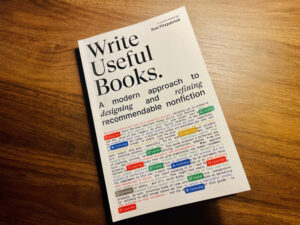Do you know what’s even better than a great book? A great book that recommends another great book!
That’s exactly how I came across Write Useful Books: A Modern Approach to Designing and Refining Recommendable Nonfiction by Rob Fitzpatrick. AJ Harper recommends it in her masterful Write a Must-Read. As soon as I finished Harper’s book, I picked up Fitzpatrick’s and promptly devoured it.
It is mainly for nonfiction writers, though some of the content about publishing and optimizing for sales may be helpful to fiction writers. At 135 pages, Write Useful Books can easily be read in a few sittings, but don’t let that fool you. This book is packed with value.
In this blog post I’ll share a summary of the book, what makes it unique, and my take on which writers will find it most, well, useful.
Marketing Optional
Fitzpatrick’s goal is to help you write a book that is so useful, it markets itself. “For properly designed nonfiction,” he writes, “ongoing marketing becomes an option rather than an obligation.” How’s that for a promise!?
And he has the experience to back it up. Fitzpatrick shares sales data from his own three books, and all three have a history of picking up steam on the strength of word of mouth. That’s how “marketing becomes optional,” by the way—by writing a book with “long-lasting recommendability.”
Fitzpatrick aims to show you how.
Readers, Your Allies
The main thing that sets Fitzpatrick’s book apart from other books for writers is his guidance on when and how writers should solicit feedback from readers.
He opens chapter 3 by asking you to imagine a builder who’s designing a house for a family, but before consulting with the family the builder just dives in and starts building.
“As absurd as it sounds,” he writes, “that’s exactly what most authors do with books. They write in secret, piling up a manuscript’s worth of beautiful words and only then start figuring out whether people want it….”
Write Useful Books teaches you how to get feedback from readers as you develop your book’s concept and structure, and throughout the writing process.
Ultimately Fitzpatrick helps you implement an iterative process of obtaining and incorporating feedback from readers, which is what produces a book that solves a real problem your readers have.
If your book helps readers solve a problem they have, they’re very likely to recommend it to others.
Marketing and Money
The last two chapters are on how to find your first 1,000 readers and optimize for sales and growth.
He covers four paths to marketing your book without favoritism for one path over another. Rather, he tells readers to pick the path that’s easiest for them.
And in the last chapter he shares ways of increasing sales and generating more revenue from your book.
[Tweet “How to write a useful book that markets itself: a review of @robfitz’s book by @chadrallen #writingcommunity”]
Conclusion
I strongly recommend Write Useful Books to anyone writing self-help, business, or another type of prescriptive non-fiction. And in so doing I’m providing evidence that Rob Fitzpatrick has written a truly useful book!
What’s the problem your book solves?





